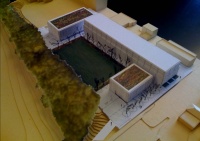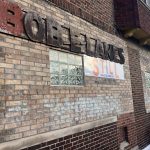UWM Dorm Building and Site Designs

Hometown
This was the last of four meetings held to discuss UWM’s most recent dorm proposal. Jim Shields, the project architect, presented his design for the building and how it fits on the 3.2 acre lot. He referred to the site as “an edge site”, indicating how it sits on the “edge” of two drastically different environments.
The design respects the river corridor, while at the same time manages to fit within an urban environment. The courtyard addresses the river corridor by extending the natural environment deep in to the site. In addition to respecting the existing forest along the bluff, the courtyard will allow students to eat lunch outside, lay in the sun or as Shields said “play a pickup game of soccer, or throw a Frisbee around.” The building connects to the urban environment by building to the property line along Cambridge and North Avenue, and following the massing and materials of buildings on North Avenue. When asked why would you build on the property line, Shields responded by saying that it helps to create “that sense of urban vitality” and that “I think it produces a better city.” He then added that “in my view as an architect, it wouldn’t be improved if it was set back 10 or 20 feet.” The 5,700 square feet of retail that fronts on North Avenue closest to the Milwaukee River is intended for a cafe that would utilize a small public plaza. The stairs and ramp down to the river will connect into this plaza and will be constructed of Ipe wood, a tropical hardwood, that has been used on the RiverWalk in the Third Ward.
Residents were also concerned about the possibility of UWM pursuing further dorms and what UWM’s plans were for the future. Tom Luljak responded to these concerns explaining that “the chancellor’s overriding goal is to have a resident hall bed for every incoming freshman,” and that each year 1800 freshman students are unable to obtain on campus housing. He went on to argue that building additional dorms both allows for more freshman to have on campus housing and that this is good for the neighborhoods because as he said “we’ve actually decreased the number of students living in off campus in the neighborhood.”
At the end of the meeting Joe Klein, Cambridge Woods Neighborhood Association President, got up and spoke. Although there had been three meetings prior to this one, he asked UWM to do a little more neighborhood outreach because in his mind the meeting schedule was just dropped on the neighborhood. Specifically, he said “this is an invitation to the university and Mandel to really do a little more of an outreach where we can have lower level meetings with people in the neighborhood and UWM.” It was evident that the purpose of these meetings was to reach out to the neighborhood and answer as many questions as possible, but despite these efforts it seems there is still some level of lingering concern.





















I was a bit surprised by Klein’s speech, as I don’t think there was much that UWM and Mandell could’ve done more to keep everyone in the loop about what was going on. There were some location and scheduling changes, but I didn’t have much problem finding all of the meetings. I noticed a couple people sighed when he got up, so I suspected that he’s known for seizing opportunities to orate.
@Adam Yea I was really surprised myself, and then a little confused as to what he was talking about. Personally I know the city did notifications and there were email lists gathered from meeting to meeting plus others were notified, and it was in the press so well that should probably be enough. That said I think what Joe would of liked would of been if they had sent emails to the neighborhood association presidents… or something to that effect.